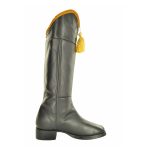
The colonists were first introduced to the Hessian mercenaries on the 15th of August 1776 on Statin Island in the colony of New York. Their first battle was coming up. Their first engagement was the battle for Long Island also known as the battle for Brooklyn Heights.
Over the course of the War for Independence, the British Government Leased 30,067 Hessian Mercenaries for just the American Revolution. It worked so well that they were used by lots of different countries. Sometimes the Hessians were on both sides of war at the same time.
Fugawee’s Hessian boot is another well made the long-lasting leather boot, Steel shank construction. Stacked leather heel, fully lined here are some of the works we used.
References to Hessian boots: Direct copy from their boots, no editing by me.
“If the shoe fits” by Bill Severn pg. 119
Hungarians introduced the hussar boot for military wear. When it first appeared in London in 1770s on the feet of the Hessian mercenaries hired by George 111 to fighting the American colonies, it was called the Austrian boot. Later, the English took to calling it the Hessian boot, the name by which it also became known in America. In France, a version of the same boot was named the Sonvaroff, after a Russian general. Whatever name was used, the basic style was a knee-high boot, usually of shiny black leather topped with gold or silver braid. The center rose to a peak at the front that frequently was decorated with a free-swinging silk tassel. Worn over tight pantaloons, the boots were first ridiculed by conservative gentlemen who didn’t intend to trade their handsome top boots for them, but they were the height of fashion by the century’s end.
“The Mode in Footwear” by R. Turner Wilcox. Page 120 [most of this is like the description from Bill Severn’s book.]
It was at this time that the hussar boot entered the mode. It was introduced to the European armies in the seventeenth century by the Hungarian hussars. When the boot appeared in London in 1770’s on the legs of the Hessian mercenaries hired by George 111 to fight the American colonists, it was first called the Austrian boot, but eventually, it became the Hessian boot to the English and the Americans. To the French, it was the hussar or Souvaroff, so named after the great Russian general of the period. (1729-1800).
The boot was first looked upon with derision, in comparison with the handsome top boot; but as happens time and time again, the scoffed at newcomer became the very height of fashion by the end of the century. Hessians were worn over the tight-fitting pantaloons, of shiny black leather, the top finished with gold and silver braid, and a silk tassel jauntily swinging from the up-peaking center front.
{this next bit is a good description of the polish that was used}
In general, bootlegs were polished to a dull finish with a viscid dressing composed of the white of an egg and lamp soot, this English cream much in demand all over Europe. Bootblacks or, by the French name, “artist polishers” opened small shops for the purpose. In London, where they were especially necessary because of the ill-paved streets and lack of drainage, there were bootblacks or “boot” stationed at most street corners. Ready to clean the footwear of gentlemen and beaux.
“Fashion in Costume 1200-2000” by Joan Nunn
[two mentions, first page 84, next page 110]Jackboots, by 1725 worn only by postillions, coachmen, etc., were succeeded by a close-fitting boot-shaped to the leg and cut away behind the knee, and by jockey tops or half jackboots which ended below the knee with a turn-down top of softer, lighter colored leather; after 1780 they were called top boots. Spatterdashes were still worn by the country, as were gaiters, introduced for the infantry around 1710-20 and worn civilians during the 1770s but considered unfashionable after 1790. Hessians – short riding boots, calf-length behind and generally curving to a point in the front below the kneecap and decorated with a tassel – appeared after 1790 but are more a feature early 19th-century dress. Boots were not worn indoors by men of fashion during this century until after 1780 when they became suitable for all occasions.
Page 110
From 1800 to 1820, high boots were general wear in both town and country. Some were adapted from military styles and named after military leaders. After 1830, high or ‘over’ boots were confined to country or sporting wear, but the short boot, worn under trousers, remained in fashion in various forms into the next century. Hessians (1790- 1850) and hussar (1800-20) were both calf-length behind, rising to a point in front just below the knee, low-heeled, and of black leather. Hessians occasionally had a narrow border contrasting colored leather around the top and were always trimmed with a tassel at the point. Hussars might have a turn-over top. Wellingtons from 1817, were like 18-century top boots without the turnover: the name was later to be used for rubber boots in the 20th-century.
“Costumes of the 17 & 18th Century” by Phillis Cunnington page 76
Hessians were short riding boots rising to a point in front to below the knee and generally decorated with a tassel (Introduced in the 1790’s)
“History of Men’s Costume” by Marion Sichel page 42
Hussar boots, popular towards the end of the century were also called hessian boots, originating from the German Principality of Hess. These were short riding boots to just below the knees, higher in the front with a tassel decoration. These were mainly black, with a colored border on the top.
“Shoes” by June Swan
{several pages listed, but I could only find a true reference in the following}
Page 33
Brummel’s other choice was the hessian, cut with a V-dip at center front with tassel; according to Rees it was ‘brought into this country from Germany in the beginning of this war about 1794 or 5, – though one of the MPs in the painting of Pitt’s Address to the Commons in the previous year also wore them, in black with re top binding. Rees also referred to them as ‘th Hessian or
Austrian boot: lately, they were of a gradual sweep in front and with a peak behind; now(1813) they are square in front without a peak behind.’ The walking attire of John Horseman in 1804 was ‘hessian boots with immense tassels’(and see fig.27). By 1830 the “Whole Art of Dress” by a Cavalry Officer says that they were ‘only worn with tight pantaloons’, and by 1861 Whyte Melville’s “Good for Nothing “says: There are no hessian boots now’ – though they did survive for military wear.
The Hessians were ousted by the wellington.
Page 39 short mention
The 1858 Dunkley account book has ‘best calf screw clump sole wellingtons at 21 shillings.’ American army boots in 1872 were brass screwed Hessians or bluchers.
Page 43
The predominant footwear, as the British set out to conquer the world, was naturally boots. “The Whole Art of Dress “1830, reports: ‘the hessian is a boot only worn with tight pantaloons. The top boot is almost entirely a sporting fashion. Although they are worn by noblemen and gentlemen in hunting, they are in general use among the lower orders, such as jockeys, grooms, butlers. The Wellington…the only boot in general wear’. The hessian survived longer in the United States. The 1858 patent for a brass toe bit is on a machine-sewn hessian with pegged sole, and the photograph, c 1879 of Billy the Kid, shows him in medium high-heeled Hessians with front dip, but no tassel, the straps hanging outside.


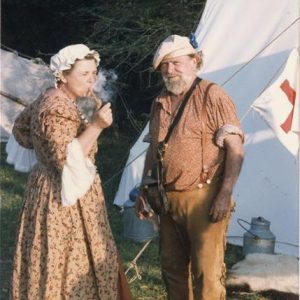
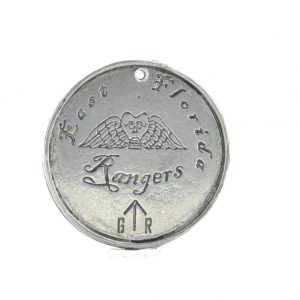
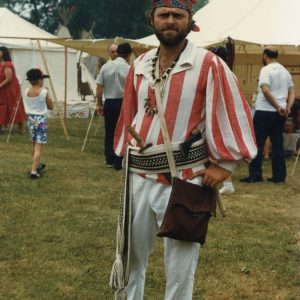
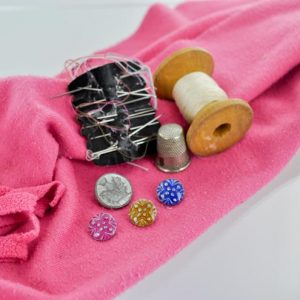
Leave a Reply